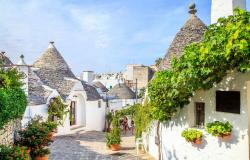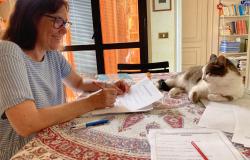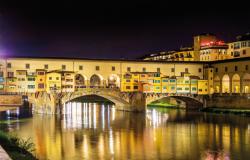Was There Really A Female Pope?
ITA:

Words by: Fabrizio Del Piero
Italian Translation Courtesy of: Andrea Antonioni
Near the Church of St John Lateran in Rome, at the corner of Via dei Querceti and Via Santi Quattro, in a niche behind a rusty gate, you can still just make out an ancient image of the Madonna and Child. Most passers-by don’t give it a second glance. After all, there are scores of such holy street shrines throughout Rome. Many may not know, but this one is somewhat different. This one concerns the legend of Pope Joan, a woman who in the Middle Ages was said to have attained the throne of St Peter, concealed in male garb under the name of John VIII.
In front of this shrine – according to the legend – the less than chaste ‘Papessa’, carried in solemn procession on a white mule, felt the pangs of labour and dropped onto the street the undeniable evidence of her fornication but more importantly the proof that the papacy had been fraudulently usurped by a woman. Fortunately, the She-Pontiff did not survive this traumatic labour, so ridding the Church of her embarrassing presence. The accident was promptly suppressed by the ecclesiastical hierarchy, though not entirely forgotten. After this episode, the popular story goes, preventative measures were put in place to determine the sex of future Popes during their enthroning. The yearly papal procession to the Lateran also changed its route so as to never again pass the odious shrine.
How much of all this may be true in fact? From historical documents it does seem that the papal procession did undergo a change of itinerary in the Middle Ages, reaching St John Lateran through the Via Labicana, a wider and more direct route. This wasn’t done in order to circumvent the embarrassing ‘little madonna’ however, but rather to seize a convenient opportunity to avoid the twists and turns through the narrow alleys in that crowded sector of town, as well as the hurly-burly of the throng of the faithful.
The Seat of the Legend
This factual detour was combined with other factors, in themselves true, but distorted by popular imagination to reinforce the picturesque story of a female Pontiff. Among these is the fact that in the Middle Ages, when Popes were crowned, together with the chanting of the Mass, the hymns and the scent of the incense burners, the Chosen One had to sit solemnly still and upright on a marble throne with a hole in the middle. It is now exhibited in the cloister of St John Lateran. It was popularly called the sedia stercorari and the hole was to allow water to drain from the seat at a time when it was left out in the open, or when it was washed. According to the ancient ritual, later abandoned, during his Coronation the new Pope also had to be seated on a second throne, but in a semi-reclining position rather than imperiously erect. This other throne was made of magnificent porphyry marble, and at its front it featured a mysterious half moon-shaped recess. A half moon recess at the front? And the Pope had to sit there in an unbecoming semi-reclining position?
Well, put all these coincidences together, add the willing credulity of the populace and then leaven this mix with the inevitable desire of tour guides to embellish a good story with a little innuendo. And the result? There has of course been a Pope Joan who managed to deceive the Sacred College of Cardinals.
It is a saucy story which even today many among the Roman people do not find incredible. Sceptics reply, quite convincingly: is it not more incredible that even the Church could cover up such a public scandal as a Pope giving birth in the middle of the street.

Vicino alla Chiesa di San Giovanni in Laterano a Roma, all’angolo tra Via dei Querceti e Via Santi Quattro, in una nicchia dietro un cancello arrugginito, si può ancora intravedere un’antica immagine della Madonna col Bambino. Molti passanti non se ne accorgono neanche. Dopotutto, ci sono centinaia di simili sacre edicole per le strade di Roma. Molti forse non lo sanno, ma questa è diversa. Questa riguarda la leggenda della ‘Papessa Giovanna’, una donna che sarebbe assurta nel Medioevo al trono di San Pietro, celata in abiti maschili e sotto il nome di Giovanni VIII.
Davanti a questa edicola – secondo la leggenda – la poco casta ‘Papessa’, che cavalcava in solenne processione su una mula bianca, ebbe le doglie del parto e scodellò in strada il frutto inconfutabile delle sue fornicazioni ma, ancor peggio, la prova del fatto che il papato era stato fraudolentemente usurpato da una donna. Fortunatamente la Papessa non sopravvisse alle traumatiche doglie, liberando così la Chiesa della sua imbarazzante presenza. L’incidente venne prontamente insabbiato dalla gerarchia ecclesiastica, ma non del tutto dimenticato. Dopo questo episodio, continua infatti la storia popolare, misure preventive vennero introdotte per controllare il sesso dei Papi durante la loro incoronazione. L’annuale processione al Laterano cambiò anche percorso per non passare più davanti all’odiata effigie.
Quanto di tutto questo può essere vero? Da documenti storici sembra che la processione papale subì veramente un cambio di itinerario nel Medioevo, raggiungendo San Giovanni in Laterano attraverso la Via Labicana più larga e diritta. Ma questo non tanto per evitare l’imbarazzante ‘madonnina’ quanto per evitare i giri e le svolte del corteo attraverso gli stretti vicoli in quell’affollato rione della città, in mezzo alla calca dei fedeli.
La Nascita della Legenda
Questa effettiva deviazione si è combinata con altri fattori, in se stessi veri ma distorti dall’immaginazione popolare, per rinforzare la pittoresca storia di un Pontefice donna. Tra questi vi è il fatto che nel Medioevo, quando i Papi venivano incoronati, insieme alle Messe cantate, gli inni e le fumigazioni con l’incenso, il prescelto doveva sedere solennemente immobile ed eretto su un trono di marmo con un buco nel mezzo. E’ tuttora esposto nel chiostro di San Giovanni in Laterano. Veniva chiamato volgarmente sedia stercoraria e il buco serviva per drenare l’acqua dal sedile quando veniva lasciato all’aperto o lavato. Secondo l’antico rituale, più tardi abbandonato, durante l’ incoronazione il nuovo Papa doveva poi sedersi su un secondo trono di marmo, ma in una posizione semi-reclina invece che imperiosamente eretta. Questo altro trono era di splendido porfido, e sul davanti presentava una rientranza misteriosa a forma di mezza luna. Una rientranza a mezza luna sul davanti? E il Papa doveva sedèrvisi in una strana posizione semi-reclina?Be’, mettete insieme tutte queste coincidenze, aggiungete la volontaria credulità popolare e fate lievitare questa miscela con l’inevitabile gusto delle guide turistiche di arricchire la storiella con insinuazioni piccanti. Il risultato? C’è ‘ovviamente’ stata una Papessa Giovanna che riuscì ad ingannare il Sacro Collegio dei Cardinali.
E’ una succosa storia che persino oggi molti romani non trovano incredibile. Gli scettici replicano, abbastanza convincentemente: non è ancor più incredibile che la Chiesa si a riuscita a insabbiare un tale scandalo pubblico, quale sarebbe stato quello di un Papa che partorisce in mezzo alla strada?











